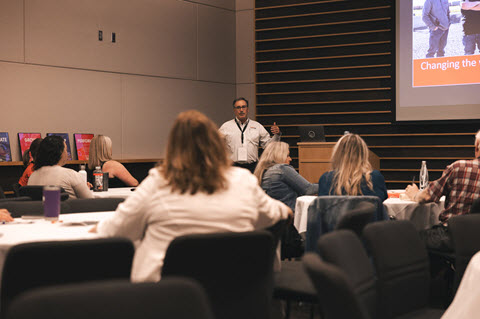- Candidates
- Login
- Set Up Account
- Create a Job Alert
- Search Tools
- Resources
- Employers

Developing a Culture of Excellence requires dedication.
Neal Horrom, Chief Operating Officer for Mercer Landmark, spoke at the AgCareers 2024 Agriculture and Food Roundtable conference about developing a culture of excellence. For more than 25 years, Neal has been involved in developing and implementing transformative strategies for large agribusinesses. His experience includes digital initiatives, organizational change management, cultural transformation and leadership development.
Developing transformative strategies for large agribusinesses is painstaking. If you are employed with a company working towards a new path of success, it is essential to recognize that leaders such as you play a critical role in the transformation.
According to Neal, leadership transformation is a crucial yet often overlooked aspect of organizational change.
Successful cultural transformation begins at the top he says. Engaging and aligning leadership is essential before extending changes throughout the company. This journey towards cultural change is gradual and requires a strategic approach.
Horrom suggests one effective strategy is to re-evaluate and alter the language used within the organization. For example, replacing terms like "company division" with "business unit" can signal a shift towards a more innovative and inclusive culture.
Language changes help break down outdated practices and encourage a mindset focused on improvement.
A critical component of this transformation is challenging entrenched attitudes. Instead of accepting the notion of "it's always been done this way," leaders must foster a culture that embraces questions like, "How can we do better?" This shift in perspective encourages continuous improvement and openness to new ideas.
Many organizations develop and promote core pillars that define their new direction to support this cultural shift. For instance, an organization might focus on "innovate" and "perform." Horrom explains that these pillars are not merely buzzwords but are integral to the company's cultural transformation.
Horrom reminds leadership teams that middle leadership plays a pivotal role in this transformation. Organizations ensure that the new culture is effectively communicated and adopted throughout all company levels by keeping mid-level leaders informed and involved. This approach also fosters shared accountability, as leaders at every level are responsible for upholding and propagating the new values.
Horrom underlines that it is important to recognize that a business strategy will falter without a supporting culture. Culture is, in essence, a reflection of the organization's brand. Leadership must embody and champion the new cultural values to be genuinely effective. Without alignment between leadership and cultural goals, efforts to transform the organization are unlikely to succeed.
In conclusion, focusing on organizational development is essential for successful leadership and cultural transformation. It requires a deliberate and sustained effort to align leadership, change organizational language, challenge outdated practices, and promote core values throughout the company. Through such comprehensive efforts, an organization can transform its culture and achieve its strategic goals.